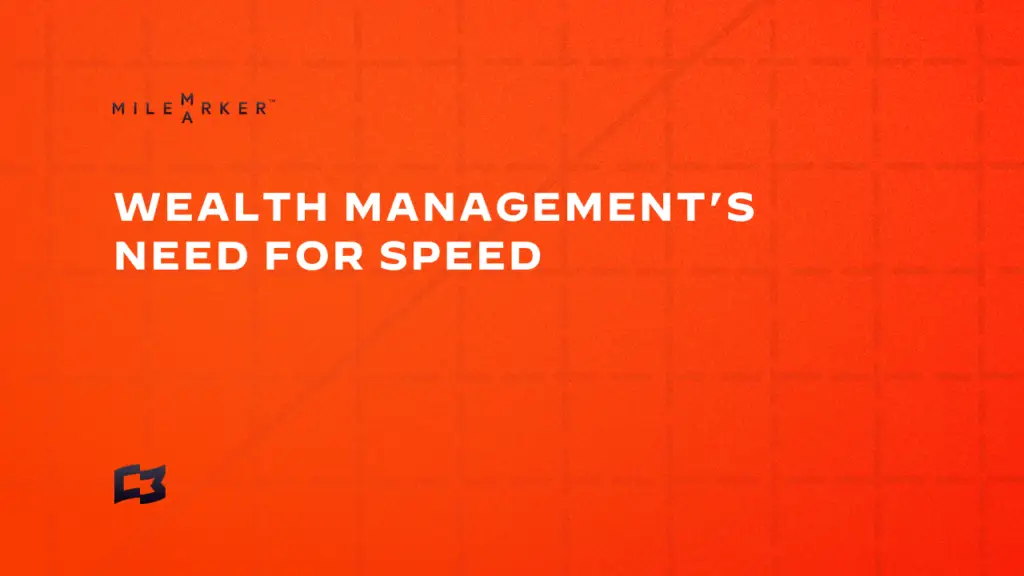My friend John runs ultra marathons.
On race days, he will run between 50 to over 240 kilometers.
Some of my other friends join him at various points in the race—not to run the whole thing, but to help set his pace, keep him focused, and push him forward.
Ultra running is more about mental toughness than physical endurance. When your body is begging you to stop, your pacers step in. They pull more out of you than you thought possible.
The best organizations operate the same way. They’re led by pace-setters.
They don’t wait for change.
They don’t overthink.
They don’t hesitate.
They move first and get where they’re going because of it.
The Best Firms Move First—the Rest Play Catch-Up.
According to a 2019 study by McKinsey, companies that make decisions quickly are twice as likely to hit revenue targets.
Yet broader wealth management and our reliant systems providers continue to operate from a position of long deliberation, extended rollout plans, and highly staggered communication. This has mainly been the case with Custody. The pace set there has considerably delayed how all other facets of our wealth management industry tend to react.
Thankfully, we now see some firms breaking the status quo and gaining the necessary posture to move at a different pace.
They prioritize execution over deliberation.
They simplify decision-making instead of overcomplicating it.
They act now and refine later instead of waiting for perfect conditions.
Those who control the pace, control the market.
Speed Isn’t Reckless. It’s Strategic.
The idea that “slow decisions are better decisions” is faulty (Hiring is the only exception, in my opinion).
The difference is speed.
The fastest firms I work with aren’t making reckless choices—they’re just not wasting time.
They don’t wait until they have 100 percent certainty to move. They trust their teams to execute without unnecessary approvals. They create a culture of urgency where progress beats perfection. They choose which partners will have the least drag and run at a similar pace.
How to Set the Pace (And Bring Your Team With You)
Want to set the pace instead of playing catch-up? Here’s how.
1. Make Decisions Twice as Fast
Set deadlines for strategic choices. Figure out what data you need to know before making the decision. Have your team gather, review, discuss, and don’t keep pushing for more information unless you are certain you missed something initially.
This doesn’t mean you are spending less time on decisions. It often means you simply bring more intensity and focus to the process.
Clear up on approval layers and trust your team to execute. This exercise often produces the next generation of leaders.
2. Cut the Bottlenecks
One of the most impactful things I see the strongest leaders do is to create a culture of running into the fire when there is an issue rather than waiting. While you want to build a culture where others embrace the challenge, you first need to set the pace by taking a fearless approach to tackling a bottleneck, blocker, or problem hindering your pace.
3. Replace Meetings With Action
Less formality, more execution.
A friend once reminded me that if you make a wrong decision, just make another one. Thankfully, most of us reading this newsletter do not work as surgeons—barring a few of my friends who are readers. Most of our choices are non-fatal, which allows us the freedom to move toward action with much less downside risk.
This allows us to improve at making decisions — while still practicing healthy habits of gaining consensus and alignment along the way.
4. Build a Culture of Urgency
Encourage your team to act, iterate, and refine as they go. Even if you don’t love how all decisions are made, progress is often your most important leading indicator—especially when our most significant competition is not other firms or internal blockers but the lack of pace of the third parties our businesses rely upon.
Set the Pace or Get Left Behind
The best organizations are moving fast, cutting through the tape, and taking the hill.
How do you need to reorient your focus to ensure that your business has the least friction possible as you move forward?

